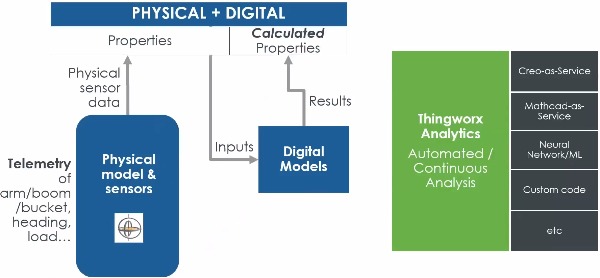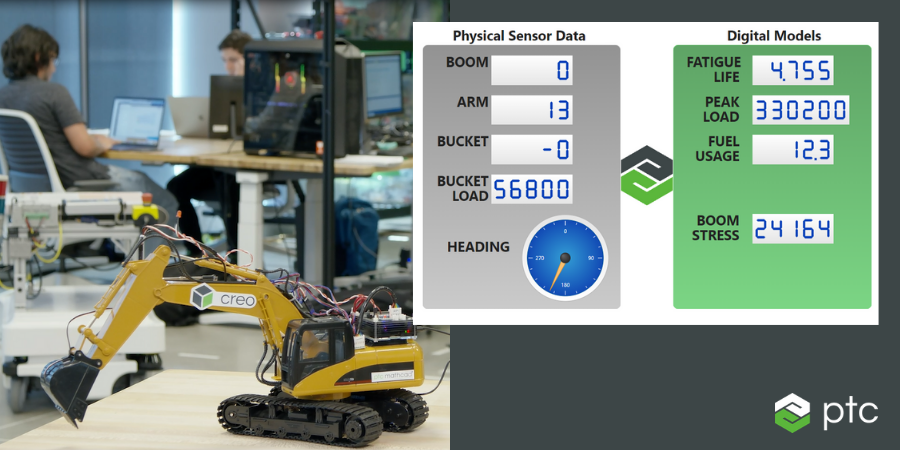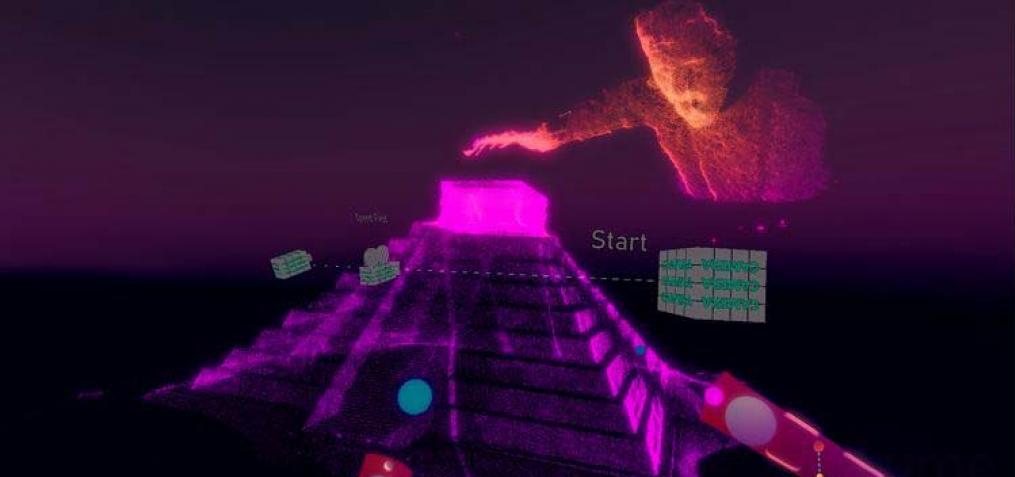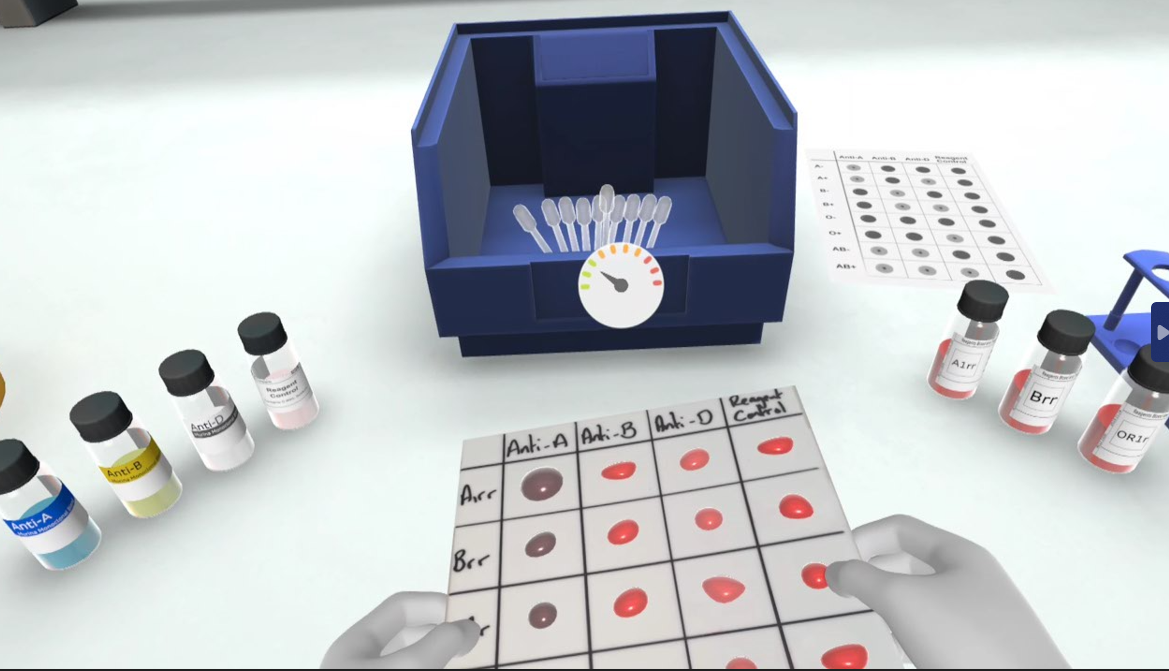There is an abundance of mechanical systems living in the physical world with critical insights hiding in plain view waiting to deliver value for industrial companies. Digital twin technology is providing the entryway into understanding their physical context while unlocking crucial insights and business outcomes, including optimization of smart, connected products and processes through prevention of failures and operational efficiency improvements.
PTC has developed a digital twin demo of a scale model excavator to illustrate the endless possibilities and business value accessible by linking the physical and digital worlds through the use of digital twins.
The Value of Digital Twin
Implementing a digital twin of a heavy-industrial asset like an excavator can improve asset uptime driving operational efficiencies, while unlocking novel insights into traditionally unanswerable questions and benefitting roles across the value chain. Underpinning these answers come through the implementation of IIoT, real-time simulation, artificial intelligence, augmented reality, cloud computing, and other complimentary digital twin technologies.
While PTC has a rich heritage in enabling engineering excellence for its customers, this demonstration focuses on the owner/operator persona and was developed with PTC and third-party technologies to illustrate the real-world value a digital twin can drive.
As with most connected industrial assets, there are sensors generating massive amounts of data to be contextualized on an IIoT platform. PTC retrofitted the excavator with compute power via a Raspberry Pi3 to harness telemetry data from pressure sensors and linear potentiometers to monitor the stroke of the cylinders and load in the bucket.
Complementing this hardware instrumentation is equally notable firmware operating on the Raspberry Pi containing an Edge Client implemented using the ThingWorx JavaSDK. This SDK is the gateway to transmit data off the excavator to a cloud-based ThingWorx server where there is an array of integrated technologies and powerful simulation models. This technology foundation is key for rolling out the next-generation digital twin use cases explained below.
The IIoT Platform Is Crucial to Industrial Digital Twins
 When managing real-time assets with digital twins, an IIoT platform is needed to contextualize the sensor data through the asset’s digital definition including the 3D models and engineering calculations and parameters.
When managing real-time assets with digital twins, an IIoT platform is needed to contextualize the sensor data through the asset’s digital definition including the 3D models and engineering calculations and parameters.
In this case, PTC identified relevant properties from the sensor feeds in ThingWorx, including the excavator arm and boom angles, bucket angle, bucket load, and other movements, which provide the foundation for several engineering simulations and AI/ML models. However, not every relevant excavator attribute can be monitored with a sensor; a digital twin is needed to fill out additional insights for certain calculations, such as center of gravity.
Real-time Simulations Yield Valuable Insights
Underpinning these advanced simulation models are unique configurations from Creo and Windchill, which are provided on-demand and orchestrated by ThingWorx. These simulations can adhere to a variety of different industrial use cases, mostly around maintaining safe operating conditions, asset uptime, and predictive maintenance.
Below are the real-time simulations generating predictive insights on the demo:
- Tip danger: An on-the-fly simulation calculating the risk of the excavator tipping based on center of mass and gravity calculations, leveraging inputs from sensors and operating conditions from the physical machine. As the arm extends further away from the excavator, weight is unevenly distributed and increases the tip risk. Setting the system up with alert thresholds can preemptively warn the operator in real-time to prevent accidents or be logged in ThingWorx for post-incident analysis.
- Boom prediction: The boom is a critical component in an excavator and continuous monitoring of its performance is an important indicator of the excavator’s health status and understanding of how heavy use impacts the asset’s useable life.
- Fatigue life estimation: Linking in the digital definition, which includes sub-assembly components such as a part of the base of the boom, can be indicators for stress analysis and simulations. By baking in assumptions, such as amplitude of cyclic loads and monitoring peak loads, the model can inform fatigue analysis of the excavator. By using Creo-as-a-Service, the component data is only triggered on-demand, when peak load parameters are breached and then updated in ThingWorx, increasing uptime and lifetime of the asset.
- Arm stress analysis: Typically, complex physics models with multiple variables can take hours to calculate, limiting real-time use cases. To resolve this, PTC used Creo Simulate to run a multitude of design scenarios, train a neural network using deep learning techniques, and embed a lightweight predictor model on the Raspberry Pi. The neural network provides predictions of maximum stress experienced, based on data gathered in real-time – in seconds. Leveraging AI/ML-based simulations at the edge can optimize compute power with embedded complex simulations; this is a potentially game-changer for digital twins of heavy-industrial assets through bolstering predictive maintenance use cases.
- Fuel efficiency: With real-time telemetry data from the excavator (engine speed/load) and qualitative factors (operator, weather conditions), PTC can predict fuel consumption per hour with the digital twin model. Using Mathcad-as-a-Service to dynamically provide these updated calculations, the user monitors predicted fuel usage and can assess the efficiency of the excavator on an operator-by-operator basis based on actual usage.
One Digital Twin, Multiple Lenses and Use Cases
There are numerous opportunities to leverage these mathematical models for multiple roles. For example, a fatigue life estimate not only helps service technician functions for predictive maintenance but also better informs engineers in their efforts to design more effective parts.
Building one digital twin and applying it to different lenses for different roles and use cases is a cornerstone of obtaining value through digital twins. Below are a few different digital twin lenses for roles, although the list can extend much further than this for an industrial enterprise.
- Engineers: For the manufacturer of the connected product, real-world product usage and performance data replaces assumptions in design calculations with operating conditions. This provides a crucial feedback loop back to product engineers and designers that can be used to improve future iterations of new products and enable generative design capabilities, further optimizing manufacturing processes.
- Operators: Knowing in real-time when a part is malfunctioning or at risk of failure is critical in preventing downtime. Using the excavator performance KPIs can also be used to assess an operator’s performance and train junior operators through augmented reality experiences.
- Service: Real-time models can quickly inform service technicians potential failures in a system, while AR provides the lens to the digital twin to service the physical machine in-situ.
Final Thoughts
The possibilities and digital twin use cases are endless when digital and physical systems converge and are provided in different lenses to get the right information to the right personnel. Both the digital definition of a product or system and telemetry data from IoT are required for businesses to reach the full potential of a digital twin and unlock next-generation use cases. Taking this twin that effectively incorporates all known sources of insights can serve several use cases without rework.
Applying simulation models to real-world performance data of heavy-industrial assets can dramatically reduce downtime and with supporting technologies like IoT and cloud computing, these digital twin implementations will increasingly become widespread and impactful.
Quelle:
https://www.ptc.com/en/product-lifecycle-report/digital-twins-value-excavator-demo




